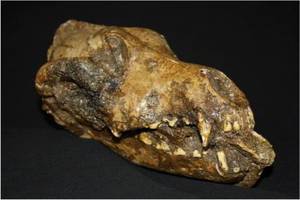Press Releases Archive
24.11.2014
People ate mammoth, dogs got reindeer
Tübingen biogeologists show how Gravettian people shared their food 30,000 years ago
Předmostí I is an exceptional prehistoric site located near Brno in the Czech Republic. Around 30,000 years ago it was inhabited by people of the pan-European Gravettian culture, who used the bones of more than 1000 mammoths to build their settlement and to ivory sculptures. Did prehistoric people collect this precious raw material from carcasses – easy to spot on the big cold steppe – or were they the direct result of hunting for food? This year-round settlement also yielded a large number of canids remains, some of them with characteristics of Palaeolithic dogs. Were these animals used to help hunt mammoths?
To answer these two questions, Tübingen researcher Hervé Bocherens and his international team carried out an analysis of carbon and nitrogen stable isotopes in human and animal fossil bones from the site. Working with researchers from Brno and Brussels, the researchers were able to test whether the Gravettian people of Předmostí ate mammoth meat and how the “palaeolithic dogs” fit into this subsistence picture.
They found that humans did consume mammoth – and in large quantities. Other carnivores, such as brown bears, wolves and wolverines, also had access to mammoth meat, indicating the high availability of fresh mammoth carcasses, most likely left behind by human hunters. Surprisingly, the dogs did not show a high level of mammoth consumption, but rather consumed essentially reindeer meat that was not the staple food of their owners. A similar situation is observed in traditional populations from northern regions, who often feed their dogs with the food that they do not like. These results also suggest that these early dogs were restrained, and were probably used as transportation helpers.
These new results provide clear evidence that mammoth was a key component of prehistoric life in Europe 30,000 years ago, and that dogs were already there to help.
 | Skull of a Palaeolithic dog |
Publication:
Hervé Bocherens, Dorothée G. Drucker, Mietje Germonpré, Martina Láznicková-Galetová, Yuichi I. Naito, Christoph Wissing, Jaroslav Bruzek, Martin Oliva: Reconstruction of the Gravettian food-web at Předmostí I using multi-isotopic tracking (13C, 15N, 34S) of bone collagen. Quaternary International (2014), <link http: dx.doi.org j.quaint.2014.09.044>
dx.doi.org/10.1016/j.quaint.2014.09.044
Contact:
Prof. Dr. Hervé Bocherens
Universität Tübingen
Fachbereich Geowissenschaften – Biogeologie
Senckenberg Center for Human Evolution and Paleoenvironment (HEP)
Telefon +49 7071 29-76988
<link mail ein fenster zum versenden der>herve.bocherens[at]uni-tuebingen.de
The University of Tübingen
Innovative. Interdisciplinary. International. Since 1477. These have always been the University of Tübingen’s guiding principles in research and teaching. With its long tradition, Tübingen is one of Germany’s most respected universities. Tübingen’s Neuroscience Excellence Cluster, Empirical Education Research Graduate School and institutional strategy are backed by the German govern-ment’s Excellence Initiative, making Tübingen one of eleven German universities with the title of excellence. Tübingen is also home to six Collaborative Research Centers, participates in five Transregional Collaborative Research Centers, and hosts six Graduate Schools.
Our core research areas include: integrative neuroscience, clinical imaging, translational immunology and cancer research, microbiology and infection research, biochemistry and pharmaceuticals re-search, the molecular biology of plants, geo-environment research, astro- and elementary particle physics, quantum physics and nanotechnology, archeology and prehistory, history, religion and cul-ture, language and cognition, media and education research.
The excellence of our research provides optimal conditions for students and academics from all over the world. 28,500 students are currently enrolled at the University of Tübingen. As a comprehensive research University, we offer more than 280 subjects. Our courses combine teaching and research, promoting a deeper understanding of the material while encouraging students to share their own knowledge and ideas. This philosophy gives Tübingen students strength and confidence in their fields and a solid foundation for interdisciplinary research.
The Senckenberg Gesellschaft für Naturforschung
To study and understand nature with its limitless diversity of living creatures and to preserve and manage it in a sustainable fashion as the basis of life for future generations – this has been the goal of the Senckenberg Gesellschaft für Naturforschung for almost 200 years. This integrative “geobiodi-versity research” and the dissemination of research and science are among Senckenberg’s main tasks. Additional information can be found at <link http: www.senckenberg.de>www.senckenberg.de.
